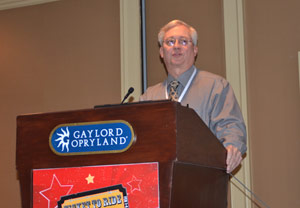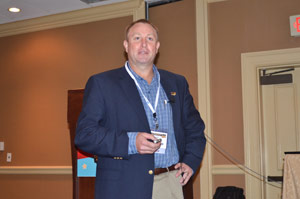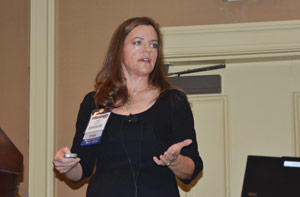Reducing the Postpartum Interval
Applied Reproductive Strategies workshop focuses on reducing the postpartum interval.
by Kasey Miller for Angus Productions Inc.
NASHVILLE (Feb. 1, 2012) — A cow’s profitability depends on the number of calves she has, so it is important to reduce the days of postpartum anestrus. That was the theme of the Applied Reproductive Strategies in Beef Cattle (ARSBC) workshop Feb. 1 during the 19th Annual Cattlemen’s College in Nashville, Tenn. A panel of three experts discussed the technical and practical implications of postpartum anestrus and fixed-time artificial insemination (AI).
Cattlemen's College is an annual educational venue hosted by Pfizer Animal Health in conjunction with the Cattle Industry Convention and NCBA Trade Show.
Michael Smith, from the division of animal science at the University of Missouri, told workshop participants that the net value of the cow is dependent upon how many calves she has, which is why reducing the postpartum anestrus interval — how long it takes for a cow to come into heat again after calving (generally 80 days) — is so important.

The net value of the cow is dependent upon how many calves she has, which is why reducing the postpartum anestrus interval is so important, said MU's Michael Smith. [PHOTOS BY KASEY MILLER]
There are several events that have to happen before the cow can be bred again, which includes uterine involution (which happens by 20 days after calving); a short seven-day cycle, which does not show heat (which happens 35 days after calving); then postpartum anestrus is prolonged to 75-80 days.
Having calves born within the first 20 days of the calving season increases weaning weight because the calves have been on the ground longer. Cows that calve in the first 20 days bring in about $50 more per calf, Smith said. Cows that calve in the second 20 days of the calving season brought in about $20 more. However, cows that calved in the third and fourth 20-day periods actually lost money. He said it takes the profit from two early-calving cows to cover the loss from one late-calving cow.
Factors affecting postpartum anestrus are cow body condition, suckling frequency, age of dam and dystocia.
Smith said that a body condition score (BCS) of 5 is ideal, that cows with any body condition higher than 5 at calving showed no major effects on the calving interval, yet cows with body condition scores lower than 5 took considerably longer to rebreed.
As suckling frequency increases, postpartum interval increases, Smith noted. Additionally, he advised to breed heifers 20 days before the cows, because it takes heifers about 20 additional days to recycle.
He said that the short, undetected cycle that triggers a full cycle can be mimicked with GnRH or a CIDR, which, in a study, showed that when timed-AI was used, pregnancy rate was 63.8% in anestrus cows, which caught them up to the 64.8% rate of natural estrus cows.

Natural estrous detection would have to approach 90% to be more effective than timed-AI, which has an average 58% pregnancy rate, said Cliff Lamb.
Cliff Lamb, of the University of Florida, discussed the effect of fixed-time AI on lifetime reproduction success. He noted that 40%-70% of cows are culled because they failed to get pregnant or calved too late in the season. If reproduction rates improve, then culling can be a tool to improve other genetic factors.
“Cows will remain in the herd longer if they become pregnant earlier and calve earlier in the season,” said Lamb.
He said that natural estrous detection would have to approach 90% to be more effective than timed-AI. Timed-AI has an average 58% pregnancy rate. In a study where half of the cows were bred on natural heat detection and the other half by timed AI, he said that timed-AI cows calved sooner, with more calving in the first 20 days.
More significantly, he said, is that the weaning weight of calves born to cows bred by timed AI was 425 pounds (lb.), compared to 387 lb. for calves bred on natural heat detection. Overall, he added, cows using timed-AI gained $49 profit per head.
To aid in using timed estrus, Lamb suggested producers use the synchronization calendar tool available at iowabeefcenter.org/estrus_synch.html.

Fertility is not a single trait so much as a complex puzzle with many pieces, said Kansas rancher Barb Downey.
Barb Downey of Downey Ranch, Kansas, shared some practical experiences of reproductive applications. She said that fertility is not a single trait so much as a complex puzzle with many pieces. Those pieces include management of nutrition, stress, genetics and fertility.
“Don’t let a factor within your control be the reason that a cow/heifer comes up open,” she advised.
-----------------------------
Editor’s Note: The above article was written under contract or by staff of Angus Productions Inc. (API). It may not be reprinted without express permission of API. To request reprint permision, contact the editor at 816-383-5200.
www.4cattlemen.com is an event coverage site provided by the editorial team at Angus Productions Inc. (API), publisher of the Angus Journal, the Angus Beef Bulletin, the Angus Beef Bulletin EXTRA and the Angus e-List. For questions about this site, to submit an article for our consideration, or to report a broken link, contact the editor at 816-383-5200; 3201 Frederick Ave., Saint Joseph, MO 64506.
API claims copyright to this web site as presented. We welcome educational venues and cattlemen to link to this site as a service to their audience.

